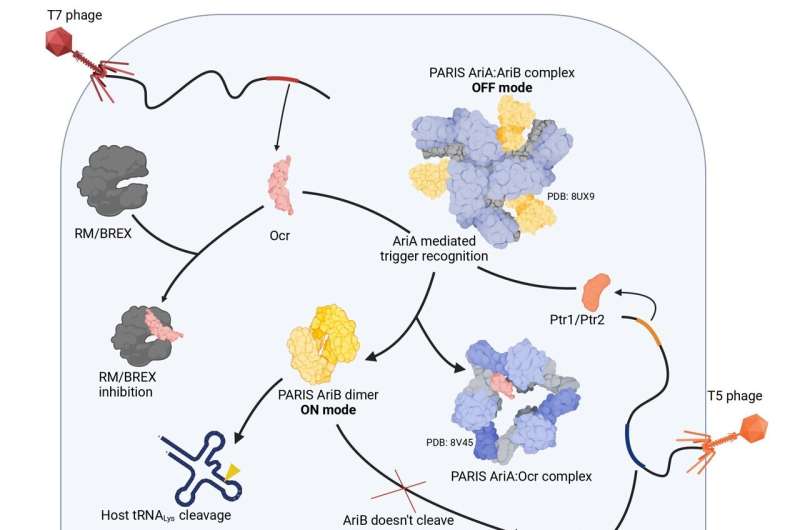This article has been reviewed according to Science X's editorial process and policies. Editors have highlighted the following attributes while ensuring the content's credibility:
fact-checked
peer-reviewed publication
trusted source
proofread
Discovery of PARIS antiviral immunity system mechanism reveals new function for viral tRNA

Bacteriophages, viruses that infect bacterial cells, are natural predators and enemies of bacteria. When a phage infects a cell, it lyses, and dozens or even hundreds of new viral particles—phage progeny—are released. The ongoing arms race between bacteria and phages has resulted in the development of a variety of bacterial innate and adaptive immune systems and anti-immune systems in phages.
At the same time, phages can sometimes play on the host's side and encode immune systems that help them compete with other phages. One of such immune systems is PARIS (Phage Anti-Restriction-Induced System).
PARIS includes two components—the AriA sensor and the AriB toxin/effector. The system is activated by the Ocr (Overcoming classical restriction) protein, which mimics the structure of DNA and, by binding to DNA-recognizing immune proteins, helps the T7 phage avoid the action of restriction-modification systems and the BREX defense system (BacteRiophage EXclusion).
A team of scientists from Skoltech, the U.S., and France, figured out the mechanism of the PARIS system and presented the results in a new article in the journal Nature.
"The PARIS system, from our point of view, is special because it directly demonstrates the coevolution of bacteria and phages. It's a link between anti-immune proteins and bacterial immunity. Bacteria have more than 150 immune systems, which means that phages also need to adapt to them and encode various anti-immune proteins. PARIS is a kind of countermeasure on the part of bacteria, allowing them to protect themselves from phages that have already evolved to inhibit other immune systems.
"In addition, PARIS can recognize a viral infection by the presence of viral proteins in the cell, rather than viral DNA, which resembles the antigen/antibody principle characteristic of eukaryotic immunity. In recent years, many similar systems have been discovered (~AVAST, CapRel, Thoeris, etc.). At the same time, when viral proteins appear in the cell, it often signals that the infection has already gone far enough and systems specific for phage DNA degradation have failed the task.
"In these conditions, an effective defense strategy is programmed cell death, which stops the development of viral infection at the population level. We managed to decipher the mechanism of such a 'suicide program' for the PARIS system," commented Artem Isaev, a corresponding author of the study, an assistant professor and the head of the Laboratory of Metagenome Analysis at the Skoltech Bio Center.
The researchers showed that AriA and AriB are assembled into a supramolecular immune complex and figured out its structure using cryo-electron microscopy. The AriA sensor is assembled into a propeller-shaped frame that coordinates the three AriB subunits and keeps the toxin inactive.
When a trigger appears in the cell—that is, an activator protein such as Ocr—the AriA sensor binds directly to it, which leads to the release of the active dimer of the toxin effector AriB. The authors showed that AriB is an RNase that cleaves lysine tRNA in a cell, which leads to translation inhibition and cell death.
"The 'arms race' in the case of PARIS is observed in its purest form: The immune systems of bacteria cause the emergence of anti-immune proteins in viruses. In response to this, the PARIS system appears in bacteria. Some phages have gone even further: Bacteriophage T5 has learned to inhibit the PARIS defense system.
"Like in a detective story, it suddenly turned out that the T5 phage in Moscow and in Paris were slightly different phages: the Moscow phage lost a fragment of the genome and several tRNA genes, which made it sensitive to the protection of PARIS.
"We showed that viral lysine tRNA is needed by the phage for successful infection of PARIS cells, since it is not cleaved by the AriB protein, and thus the T5 phage saves the cell from the toxic effects of the PARIS system, only in order to produce its own progeny," added one of the first co-authors of the work, Svetlana Belukhina, a Ph.D. student at Skoltech Life Sciences program.
"Such a consistent evolutionary struggle, the emergence of new ways of protection and anti-protection, immunity and its inhibition, still allows microbial populations, bacteria, and phages to coexist and continue to evolve together. This is a great example of how evolution cannot be stopped. In addition, our work has offered a new answer to a long-known riddle: Why do viruses encode their own tRNAs in principle?
"It turns out that in some cases, tRNA molecules help the virus to cope with the bacterial immune systems. Presumably, tRNAs may play a similar role in some viruses infecting humans," added Mikhail Skutel, a co-author of the study and Ph.D. student at Skoltech Life Sciences program.
The authors highlighted that their work was made possible by open data exchange and an equal contribution from several laboratories.
"Modern biology is impossible without collaborations and multidisciplinary expertise. In our study, we needed to employ methods of structural biology, bioinformatics, microbiology, and to work with a radioactive label, which is often impossible to combine within the same laboratory. Without international cooperation and high competition, which greatly stimulated our work, the preparation of this publication would hardly have been possible," Isaev added.
More information: Nathaniel Burman et al, A virally-encoded tRNA neutralizes the PARIS antiviral defence system, Nature (2024). DOI: 10.1038/s41586-024-07874-3
Journal information: Nature
Provided by Skolkovo Institute of Science and Technology
















